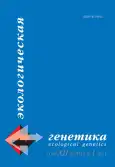Identification of new genes of nodule bacteria sinorhizobium meliloti involved in the control of efficiency of symbiosis with alfalfa medicago sativa
- Authors: Onishchuk O.P.1, Kurchak O.N.1, Chizhevskaya E.P.1, Andronov E.Y.1, Simarov B.V.1
-
Affiliations:
- All-Russia Research Institute for Agricultural Microbiology
- Issue: Vol 12, No 1 (2014)
- Pages: 39-47
- Section: Articles
- URL: https://journals.rcsi.science/ecolgenet/article/view/2473
- DOI: https://doi.org/10.17816/ecogen12139-47
- ID: 2473
Cite item
Full Text
Abstract
Full Text
##article.viewOnOriginalSite##About the authors
Olga Petrovna Onishchuk
All-Russia Research Institute for Agricultural Microbiology
Email: olony@yandex.ru
PhD, Senior scientists of the laboratory of genetic and selection of microorganisms
Oksana Nikolayevna Kurchak
All-Russia Research Institute for Agricultural Microbiology
Email: genet@yandex.ru
PhD, Senior scientists of the laboratory of genetic and selection of microorganisms
Elena Petrovna Chizhevskaya
All-Russia Research Institute for Agricultural Microbiology
Email: genet@yandex.ru
PhD, Senior scientists of the laboratory of genetic and selection of microorganisms
Evgeniy Yevgenyevich Andronov
All-Russia Research Institute for Agricultural Microbiology
Email: eeandr@yandex.ru
PhD, Head of the laboratory of microbiological monitoring and bioremediation of soils
Boris Vasilyevich Simarov
All-Russia Research Institute for Agricultural Microbiology
Email: genet@yandex.ru
Dr. Sci., Head of the laboratory of genetic and selection of microorganisms
References
- Ибрагимова М. В., Румянцева М. Л., Онищук О. П. с соавт. (2006). Симбиоз клубеньковых бактерий Sinorhizobium meliloti с люцерной Medicago sativa в условиях засоления. Микробиология. Т. 75 (1): С. 94-100.
- Кожемяков А. П., Тихонович И. А. (1998). Использование инокулянтов бобовых и биопрепаратов комплексного действия в сельском хозяйстве. Докл. РАСХН. № 6: С. 7-10.
- Лакин Г. Ф. (1990). Биометрия (4-е издание). М.: Высш. школа.
- Маниатис Т., Фрич Э., Сэмбрук Дж. (1984). Методы генной инженерии. Пер. с англ. М.: Мир.
- Онищук О. П., Курчак О. Н., Шарыпова Л. А. c соавт. (2001). Анализ различных типов конкурентоспособности у Tn5-мутантов клубеньковых бактерий люцерны (Sinorhizobium meliloti). Генетика. Т. 37 (9): С. 1-6.
- Онищук О. П., Шарыпова Л. А., Курчак О. Н. c соавт. (2005). Выявление генов Sinorhizobium meliloti, влияющих на синтез поверхностных полисахаридов и конкурентоспособность. Генетика. Т. 41 (12): С. 1617-1623.
- Проворов Н. А., Воробьев Н. И. (2012). Генетические основы эволюции растительно-микробного симбиоза. Под ред. И. А. Тихонович. СПб.: Информ-Навигатор.
- Проворов Н. А., Жуков В. А., Курчак О. Н. с соавт. (2013). Совместная миграция клубеньковых бактерий и бобовых растений в новые местообитания: механизмы коэволюции и практическое значение (обзор). Прикладная биохимия и микробиология. Т. 49 (3): С. 229-235.
- Федоров С. Н., Симаров Б. В. (1987). Получение мутантов с измененными симбиотическими свойствами у Rhizobium meliloti под действием УФ-лучей. С.-х. биология. № 9: С. 44-49.
- Чижевская Е. П., Кроль Е. А., Онищук О. П. с соавт. (1998). Физическое и генетическое картирование мутаций симбиотической эффективности на мегаплазмиде-2 штамма СХМ1 Rhizobium meliloti. Генетика. Т. 34 (9): С. 1220-1227.
- Чижевская Е. П., Онищук О. П., Андронов Е. Е., Симаров Б. В. (2011). Использование метода сайт-направленного мутагенеза для изучения функций гена SMb20332 у клубеньковых бактерий Sinorhizobium meliloti. С.-х. биология. № 3: С. 55-60.
- Юргель С. Н., Шарыпова Л. А., Симаров Б. В. (1998) Tn5-мутации Rhizobium meliloti, вызывающие повышение редокс-потенциала свободноживущих клеток и эффективности их симбиоза с люцерной. Генетика. Т. 34 (6): С. 737-741.
- Barnet M. J., Fisher R. F., Jones T. et al. (2001). Nucleotide sequence and predicted functions of the entire Sinorhizobium meliloti pSymA megaplasmid. Proc. Natl. Acad. Sci. U. S.A. V. 98 (17): P. 9883-9888.
- Beringer J. E. (1974). R1 transfer in Rhizobium leguminosarum. J. Gen. Microbiol. V. 84: P. 188-198.
- Capela D., Barloy-Hubler F., Gouzy J. et al. (2001). Analysis of the chromosome sequence of the legume symbiont Sinorhizobium meliloti strain 1021. Proc. Natl. Acad. Sci. U. S. A. V. 98 (17): P. 9877-9882.
- Finan T. M., Kunkel B., De Vos G. F. et al. (1986). Second symbiotic megaplasmid in Rhizobium meliloti carrying exopolysaccharide and thiamine synthesis genes. J. Bacteriol. V. 167 (1): P.66-72.
- Finan T. M., Weidner S., Wong K. et al. (2001). The complete sequence of the 1,638-kb pSymB megaplasmid from the N2-fixing endosymbiont Sinorhizobium meliloti. Proc. Natl. Acad. Sci. U. S.A. V. 98 (17): P. 9889-9894.
- Meade H. M., Long S. R., Ruvkun G. B. et al. (1982). Physical and genetic characterization of symbiotic and auxotrophic mutants of Rhizobium meliloti induced by transposon mutagenesis. J. Bacteriol. V. 149 (1): P. 114-122.
- Olah B., Kiss E., Györgypal Z. et al. (2001). Mutation in the ntr gene, a member of the vap gene family, increase the symbiotic efficiency of Sinorhizobium meliloti. MPMI. V. 14 (7): P. 887-894.
- Pobigailo N., Szymczak S., Nattkemper T. W., Becker A. (2008). Identification of genes relevant to symbiosis and competitiveness in Sinorhizobium meliloti using signature-tagged mutants. MPMI. V. 21 (2): P. 219-231.
- Sharypova L. A., Onischchuk O. P., Chesnokova O. N., et al. (1994). Isolation and characterization of Rhizobium meliloti Tn5 mutants showing enhanced symbiotic effectiveness. Microbiology. V. 140: P. 463-470.
- Sharypova L. A., Pretorius-Guth I.-M., Simarov B. V., Puhler A. (1992). Genetic improvement of Rhizobium strains. In: G. F. Hong (Ed.). The nitrogen fixation and its research in China. Berlin: Springer-Verlag. P. 266-285.
- Sharypova L. A., Simarov B. V. (1995). Identification of genes affecting symbiotic effectiveness of Rhizobium meliloti. In: I. A. Tichonovich et al. (Eds.). Nitrogen fixation: Fundamental and applications. Dordrecht: Kluwer Acad. Publ. P. 371-376.
- Sharypova L. A., Yurgel S. N., Keller M. et al. (1999). The eff-482 locus of Sinorhizobium meliloti CXM1-105 that influences symbiotic effectiveness consists of three genes encoding an endoglucanase, a transcriptional regulator and an adenylate cyclase. Molec.Gen.Genet. V. 261: P. 1032-1044.
- Simon R., Priefer U., Pühler A. (1983) Vector plasmids for in vitro manipulations of gram-negative bacteria. In: A. Pühler, editor. Molecular genetics of the bacteria-plant interaction. Springer-Verlag. Berlin. Heidelberg: P. 98-106.
Supplementary files






